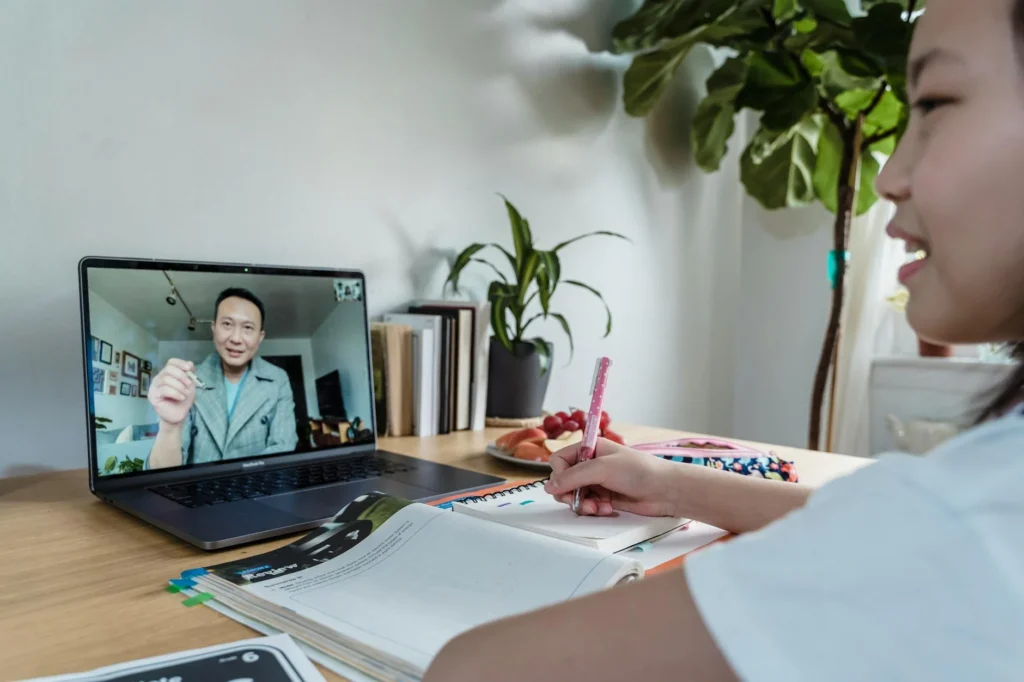
We offer a comprehensive curriculum developed by an international team, experienced teachers, and a focus on individualized and project-based learning.

We offer a comprehensive curriculum developed by an international team, experienced teachers, and a focus on individualized and project-based learning.

You’re looking to set up a virtual training lab, but you’re not sure where to start. Virtual classrooms, powered by digital technology, are an essential part of modern education, offering flexibility, accessibility, and personalized learning experiences. They break down geographical barriers, allowing students to access educational content from anywhere with an internet connection.
At FutureClassroom, you can transform your teaching experience with their technology-driven solutions, preparing young minds for a rapidly evolving world. Join them in reshaping the future of education, and discover how virtual classrooms can benefit teachers, schools, and learning institutions.

As you consider setting up a virtual training lab, you’ll want to know the benefits of virtual classrooms. The rise of online classes has further highlighted the benefits of virtual classrooms, making education more accessible and flexible. Virtual classrooms offer a range of advantages that can enhance the learning experience for students and educators alike. With virtual classrooms, you can break down geographical barriers and reach a wider audience, including remote or disadvantaged students.
Virtual classrooms can reach a wider audience, including remote or disadvantaged students. Remote learning has become increasingly important, allowing students to access educational content from anywhere in the world. You can access educational content from anywhere with an internet connection, making it possible for students to learn from anywhere in the world.
This increased accessibility can be especially beneficial for students who may have difficulty attending traditional classes due to location, mobility issues, or other constraints. By providing equal access to education, virtual classrooms can help level the playing field and ensure that all students have the opportunity to succeed. For instance, you can use virtual classrooms to create online courses that cater to students with different learning styles, abilities, and pace.
Virtual classrooms, as a part of online education, can reduce costs associated with traditional classroom settings, such as infrastructure and transportation. You can save money on building and maintaining physical classrooms, as well as reduce the need for transportation and other logistical costs. Additionally, virtual classrooms can help reduce the financial burden on students, who may not have to relocate or pay for accommodation to attend classes.
At Future Classroom, we’re transforming the way students learn by bringing the best technology-driven experiences to schools. Our mission is to prepare young minds for a rapidly evolving world, equipping them with vital coding, digital literacy, and problem-solving skills. By integrating fun, interactive, and personalized learning pathways, we make education not just a necessity but an exciting journey. Join us as we reshape the future of education.

Virtual classrooms can provide personalized learning experiences, real-time feedback, and interactive engagement, leading to improved learning outcomes. Virtual classrooms also play a crucial role in professional development, helping individuals acquire new skills and knowledge for career advancement. You can tailor your teaching approach to meet the individual needs of each student, using data and analytics to track progress and identify areas for improvement.
Virtual classrooms also enable real-time feedback and assessment, allowing you to adjust your teaching strategy on the fly and ensure that students are on track to meet their learning goals. Furthermore, interactive elements such as quizzes, polls, and discussions can help keep students engaged and motivated, leading to better academic outcomes. As you consider the benefits of virtual classrooms, you may wonder how you can create an engaging and effective learning experience for your students.
The key is to use a combination of interactive elements, personalized learning pathways, and real-time feedback to create a virtual classroom that is both fun and effective. By doing so, you can help your students achieve their full potential and succeed in their academic pursuits.
Selecting the right training platform is crucial for effective virtual training. With numerous options available, it’s essential to consider several factors, such as the type of training, target audience, and desired learning outcomes. A good training platform should offer a user-friendly interface, interactive features, and robust analytics. It should also support various multimedia formats, such as videos, simulations, and gamification.
Additionally, the platform should be scalable, secure, and compatible with different devices and operating systems. Some popular training platforms include Learning Management Systems (LMS), online training software, and virtual classroom platforms. When choosing a training platform, it’s essential to evaluate its features, pricing, and customer support to ensure it meets your organization’s needs.
Designing engaging online training content is critical for effective virtual training. The content should be relevant, interactive, and aligned with the learning objectives. It’s essential to use a variety of multimedia formats, such as videos, animations, and gamification, to keep learners engaged. The content should also be structured in a logical and easy-to-follow manner, with clear instructions and feedback mechanisms.
Additionally, the content should be accessible on various devices and platforms, ensuring that learners can access it anywhere, anytime. To create engaging online training content, it’s recommended to use instructional design principles, such as ADDIE (Analysis, Design, Development, Implementation, and Evaluation), and to involve subject matter experts and instructional designers in the content creation process.

You’re looking to create an interactive and immersive learning experience for your students, and setting up virtual labs is the perfect solution. With a virtual lab, you can provide your students with hands-on training and experimentation, preparing them for real-world scenarios and emerging technologies. But where do you start? You’ll want to consider the benefits of virtual classrooms, which offer flexibility, accessibility, and personalized learning experiences.
Virtual classrooms break down geographical barriers, allowing students to access educational content from anywhere with an internet connection. This increased accessibility can be especially beneficial for students who may have difficulty attending traditional classes due to location, mobility issues, or other constraints.
When setting up a virtual training lab, choosing the right cloud-based service is crucial. Choosing the right virtual training platform is also essential to meet evolving online training needs and customer expectations. You’ll want to compare popular services like CloudShare, LiveWebinar, and Azure Lab Services, and consider their features, pricing, and suitability for your educational needs.
For example, Azure Lab Services offers a range of features, including virtual machine templates, lab policies, and user management and access control. You’ll also want to consider the level of support and customization offered by each service. Some services may offer more advanced features, such as integration with Learning Management Systems (LMS) or support for virtual and augmented reality (VR/XR) technologies.
To help you make an informed decision, here are some key factors to consider when choosing a cloud-based service:
Features: What features does the service offer, and are they aligned with your educational needs?
Pricing: What is the cost of the service, and are there any discounts or promotions available?
Support: What level of support does the service offer, and are there any resources available to help you get started?
Customization: Can you customize the service to meet your specific needs, and are there any limitations or restrictions?
Some popular cloud-based services for virtual training labs include:
CloudShare: Offers a range of features, including virtual machine templates, lab policies, and user management and access control.
LiveWebinar: Provides a platform for live and on-demand webinars, with features like screen sharing, video conferencing, and Q&A sessions.
Azure Lab Services: Offers a range of features, including virtual machine templates, lab policies, and user management and access control, with support for virtual and augmented reality (VR/XR) technologies.

Once you’ve chosen a cloud-based service, you’ll need to configure the virtual learning environment. This includes creating virtual machine templates, defining lab policies, and configuring user management and access control. You’ll also want to consider the level of customization and flexibility offered by the service. For example, can you create custom virtual machine templates, or are you limited to pre-built templates? Can you define custom lab policies, or are you limited to pre-defined policies?
To help you configure the virtual environment, here are some key steps to follow:
Create virtual machine templates: Define the specifications and settings for your virtual machines, including operating system, software, and hardware requirements.
Define lab policies: Establish rules and guidelines for lab usage, including access control, data storage, and security protocols.
Configure user management and access control: Set up user accounts and permissions, and define access levels and restrictions for lab resources.
Before deploying your virtual lab, it’s essential to test and pilot it to ensure that it meets your educational needs. You’ll want to ensure that the virtual lab provides a smooth and seamless user experience for virtual learners. You’ll want to identify and address any technical issues, and ensure that the lab provides a smooth and seamless user experience. You may also want to consider conducting user testing and feedback sessions to gather input and suggestions from students and instructors.
To help you test and pilot the virtual lab, here are some key steps to follow:
Conduct technical testing: Test the lab’s infrastructure, including virtual machines, networks, and storage systems.
Conduct user testing: Test the lab with a small group of students and instructors to gather feedback and identify areas for improvement.
Gather feedback and suggestions: Collect input and suggestions from students and instructors, and use this feedback to make improvements and refinements to the lab.
At FutureClassroom, we’re transforming the way students learn by bringing the best technology-driven experiences to schools. Our mission is to prepare young minds for a rapidly evolving world, equipping them with vital coding, digital literacy, and problem-solving skills. By integrating fun, interactive, and personalized learning pathways, we make education not just a necessity but an exciting journey. Join us as we reshape the future of education.

Delivering effective virtual training sessions requires careful planning, preparation, and execution. The trainer should be familiar with the training platform, content, and technical requirements. It’s essential to establish a clear agenda, set expectations, and encourage learner participation. The trainer should also use interactive features, such as polls, quizzes, and breakout rooms, to keep learners engaged.
Additionally, the trainer should provide clear instructions, feedback, and support throughout the session. To ensure a smooth delivery, it’s recommended to conduct a technical check before the session, have a backup plan in place, and evaluate the session’s effectiveness through feedback and analytics.
Virtual training presents several challenges, such as technical issues, learner engagement, and time zone differences. To overcome these challenges, it’s essential to have a contingency plan in place, such as a backup internet connection or a technical support team. The trainer should also use interactive features and encourage learner participation to maintain engagement. Additionally, the trainer should be flexible and adaptable, adjusting the training content and delivery to meet the learners’ needs.
To address time zone differences, it’s recommended to use asynchronous training methods, such as pre-recorded videos or online discussions, or to schedule training sessions at times that accommodate different time zones. By being proactive and flexible, trainers can overcome common challenges and deliver effective virtual training sessions.
As you set up your virtual training lab, you’ll want to ensure that you’re following best practices to provide an effective and engaging learning experience for your students. Implementing best practices ensures that your virtual training solutions are effective and engaging for your students. You can start by defining clear learning objectives and outcomes, and aligning them with the virtual training lab.
This will help you create a focused and structured learning environment that meets the needs of your students. You’ll also want to consider providing training and support for both students and instructors, including technical support, pedagogical guidance, and feedback mechanisms. This will help ensure that everyone is comfortable and confident using the virtual lab, and that you’re getting the most out of your investment.

Defining clear learning objectives and outcomes is crucial when implementing a virtual training lab. You’ll want to identify what you want your students to learn and achieve, and how the virtual lab will help them get there.
You can start by asking yourself questions like: What are the key skills and knowledge that I want my students to acquire? How will the virtual lab help them develop these skills and knowledge? What are the specific learning objectives and outcomes that I want to achieve? By answering these questions, you can create a clear and focused learning environment that meets the needs of your students. At FutureClassroom, we’re transforming the way students learn by bringing the best technology-driven experiences to schools.
Our mission is to prepare young minds for a rapidly evolving world, equipping them with vital coding, digital literacy, and problem-solving skills. By integrating fun, interactive, and personalized learning pathways, we make education not just a necessity but an exciting journey. Join us as we reshape the future of education.
Providing training and support for students and instructors is essential when implementing a virtual training lab. You’ll want to ensure that everyone is comfortable and confident using the virtual lab, and that you’re getting the most out of your investment. You can start by providing technical support, such as troubleshooting and maintenance, as well as pedagogical guidance, such as instructional design and delivery.
You’ll also want to establish feedback mechanisms, such as surveys and focus groups, to gather input and suggestions from students and instructors. This will help you identify areas for improvement and make adjustments to the virtual lab to better meet the needs of your students. Some ways to provide training and support include:
Offering online tutorials and guides
Providing one-on-one support and coaching
Establishing a community of practice for instructors and students
Creating a knowledge base and FAQs
Monitoring and evaluating the effectiveness of your virtual training lab is critical to ensuring that you’re meeting your learning objectives and outcomes. You’ll want to track student progress and assess learning outcomes, using metrics such as completion rates, quiz scores, and satisfaction surveys. You’ll also want to identify areas for improvement, such as technical issues or instructional design flaws, and make adjustments to the virtual lab to address these issues. Some ways to monitor and evaluate effectiveness include:
Using analytics and reporting tools to track student progress and engagement
Conducting regular surveys and focus groups to gather feedback and input
Establishing a system for tracking and addressing technical issues and support requests
Using assessment and evaluation tools to measure learning outcomes and mastery of skills and knowledge.
Remember, virtual classrooms offer a range of advantages that can enhance the learning experience for students and educators alike. With virtual classrooms, you can break down geographical barriers and reach a wider audience, including remote or disadvantaged students.

At FutureClassroom, we’re transforming the way students learn by bringing the best technology-driven experiences to schools. Our mission is to prepare young minds for a rapidly evolving world, equipping them with vital coding, digital literacy, and problem-solving skills. By integrating fun, interactive, and personalized learning pathways, we make education not just a necessity but an exciting journey. Join us as we reshape the future of education.
To get started, you can explore our website and learn more about our virtual classroom solutions. You can also contact us to schedule a demo or consultation with one of our experts. We’ll work with you to understand your specific needs and develop a customized plan to implement virtual classrooms in your institution.
Some ways to get started include:
Scheduling a demo or consultation with one of our experts
Exploring our website and learning more about our virtual classroom solutions
Contacting us to learn more about our pricing and packages
Joining our community of educators and institutions to stay up-to-date on the latest trends and best practices in virtual education
By taking the next step and partnering with FutureClassroom, you’ll be able to provide your students with a more engaging, effective, and personalized learning experience. You’ll also be able to stay ahead of the curve and prepare your students for success in an increasingly complex and rapidly changing world. Virtual classrooms offer a range of advantages that can enhance the learning experience for students and educators alike.
With virtual classrooms, you can break down geographical barriers and reach a wider audience, including remote or disadvantaged students. So why wait? Join us today and start transforming your teaching experience with virtual classrooms.

FutureClassroom is Southeast Asia's largest coding platform for K-12, empowering students with essential skills in Web Development, Game Development, Python, and AI. Aligned with Cambridge and Pearson standards, our platform combines interactive learning and real-world projects to prepare young learners for a future driven by technology.
View all posts
FutureClassroom is Southeast Asia's largest coding platform for K-12, empowering students with essential skills in Web Development, Game Development, Python, and AI. Aligned with Cambridge and Pearson standards, our platform combines interactive learning and real-world projects to prepare young learners for a future driven by technology.
Get all the latest information, support and guidance about the cost of living with kindergarten.
Start Registration